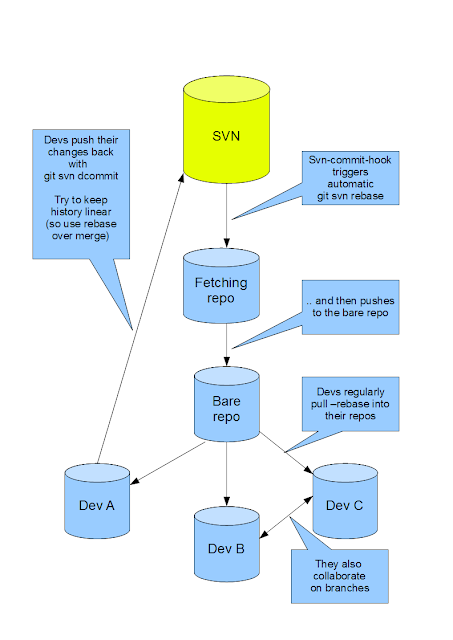I've read a great deal of "go from svn to git" and other "git-svn workflow" articles on the web, and still I think they often deal with overly simple situations. They are often targeted at guys who just want to use git and hack locally, without using the full power of git, like pull, fetch, merge and the like between multiple developers who would all have cloned the svn repository with git-svn, then still expect to be able to push their changes any time to the (official) svn repository, and get back to working in git and sharing their stuff etc.
Whenever these articles admit you can't do everything you'd do in pure git, the consequences and possible screw ups are never clearly explained (or maybe it's just me ?). Even the git-svn man page mentions caveats, but not really in an extensive manner.
Based on what I've read, I feel there could be problems when git-svn is used in that specific way, which I'll describe below. Can someone tell me if I'm right about this ?
Here is the "wanted" way of doing things:
- We have a project in a svn repository
- Developer A git-svn-clone's the svn repo. He begins to hack things locally
- Developer B git-svn-clone's the same svn repo. He begins to hack things on his own.
- After doing that for some time, possibly adding devs C/D/..., and having other developers who do "standard" svn commits to the original repo, the git users would want to share their code and do all kinds of git magic.
- Any one of those git users would like to be able to push the now merged changes to svn (dcommit?)
My question is: am I dreaming? I read some time ago, in a git book I think, that git-svn-clone could create git repositories that are of course a "mirror" of the svn repo, but that git repos created that way by different developers would have different "ids" and commits would have different hashes. So my understanding was that those git repos wouldn't share any common git ancestor, and thus wouldn't be able to use all the git commands you need to share, merge, and so on. Is it true, are we going to face problems with this workflow ?
Sometimes I read this could be done, using at least an "official" bare git repository, that would be the only one to be git-svn-cloned, and all git users would have to start form this one. Then you need someone who is in charge of this central git repo, and gathers the changes between the git devs, before dcommiting everything to the svn repo. This would be the only way for git users to be "unaware" that the original git repo comes from svn, and would let them use all git commands as they like. The only person who would need to be fluent in both git and svn (and know about git-svn caveats) would be the "merge manager" (or whatever he's called).
Am I completely misunderstanding git-svn caveats ? Is there any simpler way of doing this ?


The problem is step 4 of course. A dcommit tries to replay your local history to the server. Dcommit pretends that you're a SVN client. Now, if the code you're dcommitting isn't only from you, that's something that is hard to dcommit to SVN.
Here's what the guru writes on the matter: